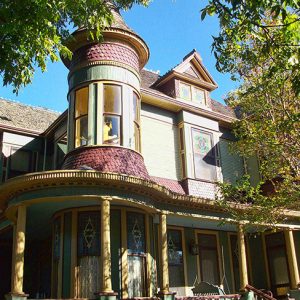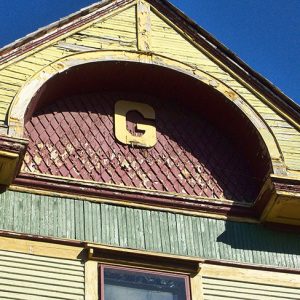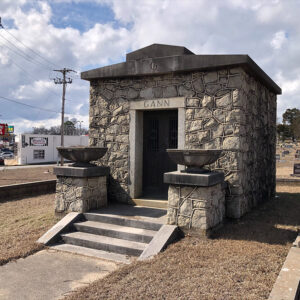calsfoundation@cals.org
Gann House
The Gann House is among the oldest buildings still standing in Saline County. The Gann House also reportedly had the first indoor bathrooms in the city of Benton (Saline County). It was built in 1895 in the Queen Anne style as the private residence of prominent doctor and freemason Dr. Dewell Gann Sr. and his family. Gann was born on March 31, 1863, in Atlanta, Georgia. In Arkansas, his family became well known for its contributions to history and to the field of medical science. The house was added to the National Register of Historic Places on January 2, 1976, a few months after what is now the Gann Museum, immediately neighboring it on South Market Street in Benton, was added to the National Register.
Dr. Gann received his medical training in Atlanta at Southern Medical College, graduating in 1886. In 1889, he moved to Benton. Gann married Martha Harding Whithorne, daughter of Colonel Samuel Whithorne, then owner of the Saline Courier. In Benton, Gann worked as a physician for multiple companies; eight of them were industrial plants, and four were railroads including the Hot Springs–Pine Bluff Railroad. In addition, he had his own private practice in a small office built next to his home. This office, now the Gann Museum, was built by patients who could not otherwise pay for their treatment. Gann was also a member of the Scottish Rite Masonic Order of Saline County. Martha Gann was one of twelve women chosen to represent Arkansas at the first inauguration of President Franklin Delano Roosevelt in 1933. She died in 1940, and Dr. Gann died on September 25, 1945, at the age of eighty-two. He was credited by the Arkansas Gazette for organizing the Saline County Medical Society in 1903.
The house was next owned by the Ganns’ son Dr. Dewell Gann Jr., who was born on September 14, 1890. He earned an MS from Indiana University in 1914 and a Doctor of Science from what was then known as Little Rock College, now the University of Arkansas at Little Rock, in 1919. During World War I, between degrees, Gann Jr. had received extensive training while serving as a captain and surgeon in the Panama Canal Zone, ultimately attaining the rank of lieutenant colonel. After the war, he worked as a surgeon for both Arkansas Children’s Hospital and what is now Baptist Health. He joined the faculty of the University of Arkansas Medical School (now the University of Arkansas for Medical Sciences) in 1914 as professor of surgery. Gann Jr. remained there as a professor until his retirement from teaching in 1936. He served as chief of staff at St. Vincent’s Hospital in Little Rock (Pulaski County) from 1922 to 1927 and as chief surgeon from 1927 to 1936. The younger Dr. Gann was most famous for inventing a medical device called the Gann Resuscitator, which was purchased by the U.S. government in 1940, and probably saved lives during World War II. He was a member of many prestigious societies including the American College of Surgeons; the Royal College of Surgeons in Edinburgh, Scotland; and the International College of Surgeons in Geneva, Switzerland. He died on January 9, 1960, at his home in Benton at the age of seventy, reportedly after an illness of more than twenty years.
In the late 1970s, David Demuth, who was president of Benton’s Gingles Hardware and Furniture, Inc., purchased the Gann House from Gracie Henry Smith of El Dorado (Union County) for an undisclosed amount. Demuth’s widow sold the house in the early 1980s to Sam Gibson and George D. Ellis, and on March 1, 1992, they, in turn, sold the house to state Senator Doyle L. Webb II and his wife, Barbara. Renovations began at that time to help keep the original house accurate to its period and structurally sound. In 1998, the Webbs added a 2,063-square-foot addition to the first floor of the house. This portion houses modern amenities like a pool, a deck, a garage, and more rooms. With the Webb addition, the house now covers more than 5,000 square feet and is one of several historic homes Webb and his wife now own in Benton, including properties in the Gann Row Historic District. Webb served in the Arkansas Senate from 1995 to 2002 and as the chair of the Republican Party of Arkansas.
The house is two stories tall with a multi-gabled roof, a round two-story turret on its northwest side, and an offset bay on the southwest side with a large “G” inside it. The five-gabled roof is crowned with iron ornamentation along its borders. Its second story recedes inward to allow the stained-glass windows to become small bays. All of these windows protrude several inches from the house walls. There are sixteen rooms in the original structure, totaling 3,248 square feet of living space. The exterior paint scheme is green and purple, with ornate shingles on the main house and wood siding on the modern addition to its first floor. There are also three front doors, one having been used as an entrance to Dr. Gann Jr.’s “night office.” The house also has four sets of French doors and is adorned with at least sixteen hand-etched stained-glass windows (one for every room). A large porch on the first story has highly ornamented wooden columns supporting the second story. In the interior of the original structure, there are hundreds of tiny “G’s” hidden throughout, and a large wooden staircase leads to the second-story landing.
For additional information:
Herndon, Dallas Tabor. A Centennial History of Arkansas, Vol. 2. Chicago: S.J. Clarke Publishing Company, 1922.
“Miss Irl Gann.” Arkansas Gazette, October 28, 1927, p. 10.
Morrow, Claudia. “Gann House.” National Register of Historic Places nomination form. On file at Arkansas Historic Preservation Program, Little Rock, Arkansas. Online at http://www.arkansaspreservation.com/National-Register-Listings/PDF/SA0027.nr.pdf (accessed September 11, 2020).
“Noted Doctor, Dewell Gann Dies at Benton.” Arkansas Gazette, January 11, 1960, pp. 1A, 2A.
Walker, Joe. “Gann’s Legacy Lists Medical, Historic Contributions.” Benton Courier, June 10, 1985, p. 6.
Woods, Betty. “Gann House East Lake Victorian Marvel.” Arkansas Democrat, January 30, 1977, p. 1C.
Cody Lynn Berry
University of Arkansas at Little Rock
 Historic Preservation
Historic Preservation Post-Reconstruction through the Gilded Age, 1875 through 1900
Post-Reconstruction through the Gilded Age, 1875 through 1900 Gann House
Gann House  Gann House Insignia
Gann House Insignia  Gann House
Gann House  Gann Mausoleum
Gann Mausoleum 




When I was a girl of thirteen in 1950, my mom, dad, and I lived across the street from the Gann House in one of their properties. I think my dad must have collected rent from various of their rent properties, so I would occasionally go with him to the Gann House for short visits. They were always in bed, allegedly sick–they never went out of the house. And my special memory is that I was allowed to go into one of Mrs. Gann’s closets and play in her beautiful–at that time, vintage–ballgowns and fancy shoes. I loved getting to go to their house, even though it was not well kept (they had one employee: a kind black man named Jim who took care of them. He cooked, shopped, ran errands, kept house, etc.). Seemingly, Jim mostly paid attention to their bedroom where they lived. Sometimes I would see him driving their old black I-think-it-was-a-Cadillac. But, even though not-cared-for, the car still had the air of affluence. It was a grand old house, and I’m delighted that it is being preserved.